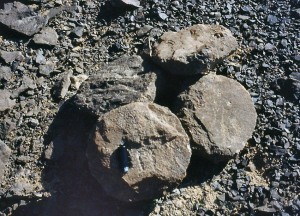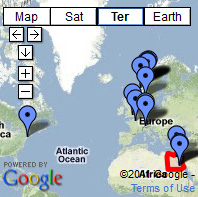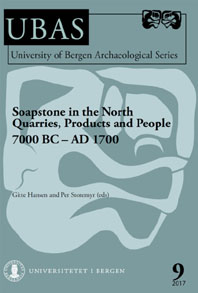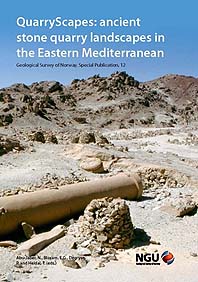
What a quarry! The central summit at Gebel Manzal el-Seyl in the Eastern Desert of Egypt. Nearly 5000 years old. Extraction took place at the top, spoil from the workings were deposited down the slope. Photo: Per Storemyr
Looking for old quarries in Egypt’s Eastern Desert means that you are not only walking in the footsteps of ancient quarrymen, but also of archaeological geologist Jim Harrell. Jim has crisscrossed the Eastern Desert and found several very important quarries over the last 20 years, one of which is Gebel Manzal el-Seyl, in the northern part of the hilly desert. Manzal el-Seyl is so important because it shows that there was organised production of material for stone vessels in remote parts of the Eastern Desert by the Early Dynastic period (2920-2575 BC). This is when vessel production was at its peak in Egypt.
Manzal el-Seyl means “where the water divides”, which refers to wadis diverting their flash floods at both sides of a marked hill. A little east of this hill is another one with dozens of quarry workings, the largest of which is very nicely placed at the summit. This is in Precambrian volcanic country and the stone that was so attractive for the Ancient Egyptians is a slightly metamorphosed greenish tuff, quite hard, but still relatively easy to carve.
The tuff was extracted by various types of dolerite hammerstones and stone mauls, taking advantage of natural cracks, perhaps also with the aid of inserting naturally shaped rock wedges. And then the blocks were dressed roughly into the shape of various types of stone vessels. After the long transportation on donkey back to the Nile Valley, final shaping using drills/borers was done in workshops around the great ancient sites, mainly in Upper Egypt (especially at Abydos).

Tuff vessel (plate), originating at Manzal el-Seyl, in the Kom Aushim Museum in the Faiyum. Photo: Per Storemyr
Known vessels from Manzal el-Seyl only make up a small percentage of the great record of stone vessels from Predynastic and Early Dynastic Egypt, encompassing a great variety of stone such as travertine, gypsum, blue Chephren gneiss and many others. But there was a growing preference for the relatively easily workable tuff from the late First Dynasty. This may have been associated with increasing use of the effective, so-called “figure-of-eight” shaped drills. Thus, vessels could be made faster, but the quality became poorer. It might be seen as a growing “industrialisation” of craftsmanship, a consequence of tighter organisation of state administration at this crucial time for the development of the Ancient Egyptian state. However, in addition to properties, the use of stone from a so remote source may have been considered a value in itself, similar to what has been suggested for Chephren’s Quarry – a much larger provider of stone for vessels at the early times of the Egyptian state.
Abandoned vessel blanks strewn in the hundreds and thousands at the Manzal el-Seyl quarry often come with a peculiarity: Crudely inscribed upside-down U-forms, similar to what is known at ceramic vessels. They are not found at finished vessels and hence must have had a specific meaning in the context of quarry work. There is no definitive interpretation of the upside-down U-forms, but since they are similar to the hieroglyph for the numeral 10, it has been suggested that they may have been used for accounting purposes to mark every tenth blank produced. But the idea has also been forwarded that the upside-down U-form is a (now lost) toponym for an administrative region that operated the quarries.
In the Eastern Desert, Manzal el-Seyl is one of three known quarries for early vessel production. The others are Gebel Umm Naqqat, also discovered by Jim Harrell, and famous Wadi Hammamat. But this beautiful desert ought to hide several more quarries…
Want to know more?
Here’s a summary of the series, with links to all the stories: Ten quarries of Ancient Egypt: Series summary
Gebel Manzal el-Seyl/stone vessels/Eastern Desert:
- James A. Harrell, V. Max Brown and Masoud Salah Masoud, 2000. An Early Dynastic Quarry for Stone Vessels at Gebel Manzal el-Seyl, Eastern Desert. Journal of Egyptian Archaeology, 86, 33-42. Online at JSTOR
- James A. Harrell, 2004. A stone vessel quarry at Gebel Umm Naqqat: Egyptian Archaeology, 24, 34-36
- Denys A. Stocks, 2003: Experiments in Egyptian Archaeology: Stoneworking Technology in Ancient Egypt. Routledge. [On “figure-of-eight” shaped drills, see Google Books, p. 142 ff]
- Jim Harrell’s website: http://www.eeescience.utoledo.edu/faculty/harrell/Egypt/AGRG_Home.html
- S. Bielen, 2004: The funerary objects from the Early Dynastic royal tombs at Abydos in the Royal Museums of Art and History in Brussels. In: Hendrickx et al. (eds.), Egypt at its Origins, 2004, 621-35. Google Books
General on Ancient Egyptian quarries:
- Harrell, J.A. & Storemyr, P. (2009): Ancient Egyptian Quarries – An Illustrated Overview. In: Abu-Jaber, N., Bloxam, E., Degryse, P. & Heldal, T. (eds.): QuarryScapes. Ancient stone quarry landscapes in the Eastern Mediterranean, Geological Survey of Norway Special Publication 12, 7-50. PDF (7,6 MB)
Map







